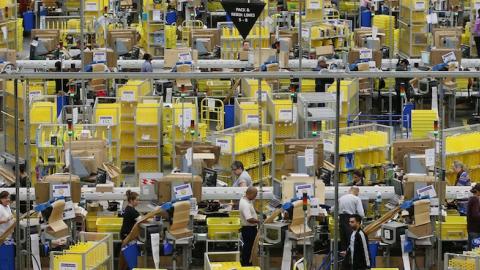Incomes are up. Jobs are so plentiful that employers complain they cannot find workers who have the right skills and can pass a drug test, and college graduates are entering the best market in years. Industrial output is rising. Housing starts rose 6.6 percent and building permits 3.6 percent in April from a month earlier. Economists at the Federal Reserve Bank of Atlanta predict annual growth this year will "snap back" to 2.5 percent from the miserable first-quarter rate of 0.5 percent, and the president of the New York Fed thinks the economy is strong enough to withstand two interest rate increases this year, a view shared by many of his colleagues and, it seems, by the markets.
None of these favorable economic developments could reverse the decline of America's department stores, which saw sales in the past year drop by 1.7 percent while shopping on Amazon, rival web sites and apps rose 2.4 percent. Macy's, Nordstrom, Kohl and Dillard, among others, reported declining sales and profits, store closings, and a flight from many shopping malls. One television news channel posted this obituary, "Brick and mortar chain stores died this week, after a long illness. Born along Main Street, raised in shopping malls across post-World War II America, the traditional store enjoyed decades of good health, wealth and steady growth. But in recent years its fortunes have declined. Survived by Amazon.com and online outfits too numerous to list."
It might have added that T.J. Maxx, the apparel discount chain, with sales rising and new store openings adding to its 1,000 existing stores, is making a hash of traditional department stores' efforts to attract customers to their new low-price stores, among them Nordstrom's Rack and Macy's Backstage. With one disrupter, Amazon, eating into the department stores' business, and another, T.J. Maxx, making adaptation to the new retail environment difficult, Macy's and others find themselves caught between two disrupters. Not a good place to be in an economy in which consumers are enjoying an in-store hunt for discounts on T.J. Maxx's continuously refreshed inventory of high-fashion items, and the time-saving convenience and instant gratification offered by Amazon.
Consumers have also made life difficult for department stores by deciding to spend less on the stuff now forlornly crowding the shelves and racks of those stores, often poorly displayed, and more on their homes and entertainment. U.S. sales at DIY and home improvement chains Lowe's and Home Depot rose 7.5 percent and 7.4 percent, respectively, in the first quarter, in part because the bulky nature of their products makes it difficult for Amazon to compete, and in part because these chains' customers need in-store advice when buying paints, building supplies, tools and the like. Consumers also seem willing to do without that new sweater, especially if it being sold at full price, in order to tuck into locally sourced meals concocted by famous chefs in "fast-casual" restaurants in which sales are running about 5 percent ahead of last year, after a 9 percent increase in 2015.
Competitors of Amazon face three major problems.
* They have to satisfy shareholders who have been accustomed to regular profits, while Amazon founder Jeff Bezos' 18 percent share of the company's equity gives the billionaire (net worth $61 billion according to Forbes) effective control, especially since other shareholders are in for the long-run increase in the value of their shares, rather than quarterly profits, of which there have been very few.
* Any retailer trying to stave off or take on Amazon faces a huge distribution infrastructure build over the past decades, which few save Walmart can afford to duplicate, and the Arkansas-based retailer only because it has some of the pieces of such an infrastructure already in place.
* Amazon has persuaded millions of customers to sign on to Amazon Prime, which provides "free", same-day delivery everything from books to cosmetics—nothing new about any of that—and equally "free" or almost-free and timely delivery of everyday household supplies from Amazon's Pantry, which is new. And means that Bezos, who demonstrated his good sense last week by turning down entreaties from disgruntled Republicans to mount a third-party candidacy to keep Donald Trump from occupying the Oval Office, has supermarkets in his sights.
Having seen what complacent department store managements have brought on themselves by paying too little attention to the threat posed by Amazon, Walmart, the world's largest retailer, has taken notice of Bezos' new foray into groceries and household stuff, and his threat to turn its 4,600 U.S. stores into quaint memories of by-gone days. It is building a regional two-day delivery network around eight massive warehouses and its fleet of 6,000 tractor trailers. Whether that $2 billion investment will fend off Amazon is not certain, as the on-line retailer is unlikely to end its serial innovations, such as its new inexpensive home device, Echo, which incorporates Alexa, a robotic voice personal assistant) can play music and provide search results in response to voice commands, and allow customers to place orders by voice instructions. "Alexa, order a case of Kleenex", and the tissues are on the way. Bezos is not alone in believing that voice commands are set to replace typed instructions—some three million customers have already "hired" the ever-ready Alexa as their personal assistants.
Worse from the point of view of competitors is Dash, a Wi-Fi-connected button that with one touch re-orders consumers' essential household products; detergents, toilet paper and the like. This is as close to a locked-in customer base as any retailer can have. And as soon as next week, private label products from diapers to nuts to baby foods—Happy Belly, Wickedly Prime and Mama Bear—will be available, aimed primarily at millennials who have been brought up to trust the Amazon name.
None of this means that Amazon is invincible: No tree grows to the sky. Steve Sadove, former CEO of high-end chain Saks Fifth Avenue, says traditional department stores can survive if they create a unique "experience", such as restaurants that give customers a reason to visit the store -- a feature London department stores such as Harrod's, Fortnum's and Selfridge's introduced decades ago. Others look for malls to become "destinations-of-choice" for customers, with features such as the ice-skating rink in Houston's Galleria. But even Sadove concedes that over the next few years hundreds of department store locations will be converted by property developers into gyms, residential towers, or office uses. Meanwhile, consumers are in the saddle and ride the retail sector.
Investors are betting on Bezos: They have driven Amazon stock up by 65 percent and Walmart's share price down by 7 percent in the past year. Like consumers, however, investors are a fickle lot, making resting on one's laurels a costly exercise. Doubt that, and ask executives at one-time high flyer Walmart. Or Macy's.
Oh, yes. Amazon is opening bricks-and-mortar stores in Seattle and San Diego selling, get this, books. Anyone remember Borders?
















